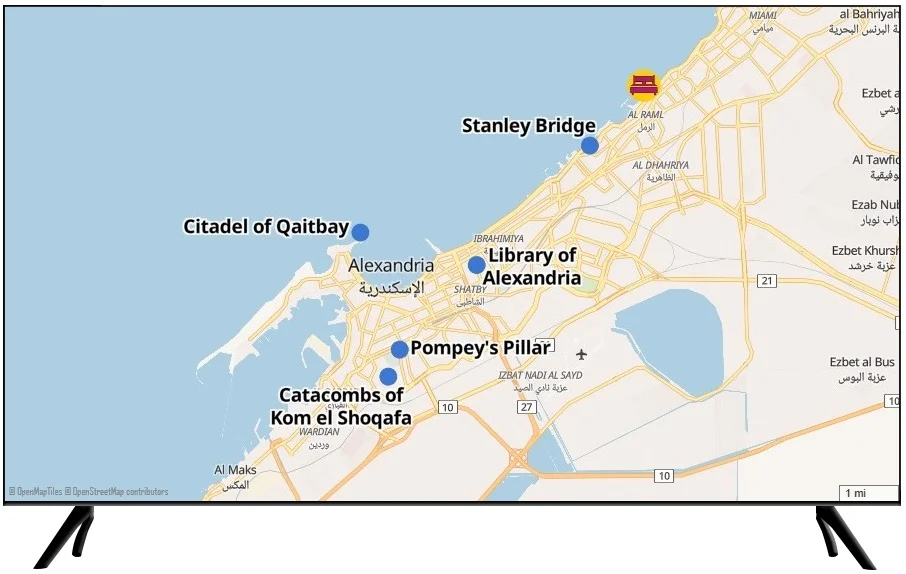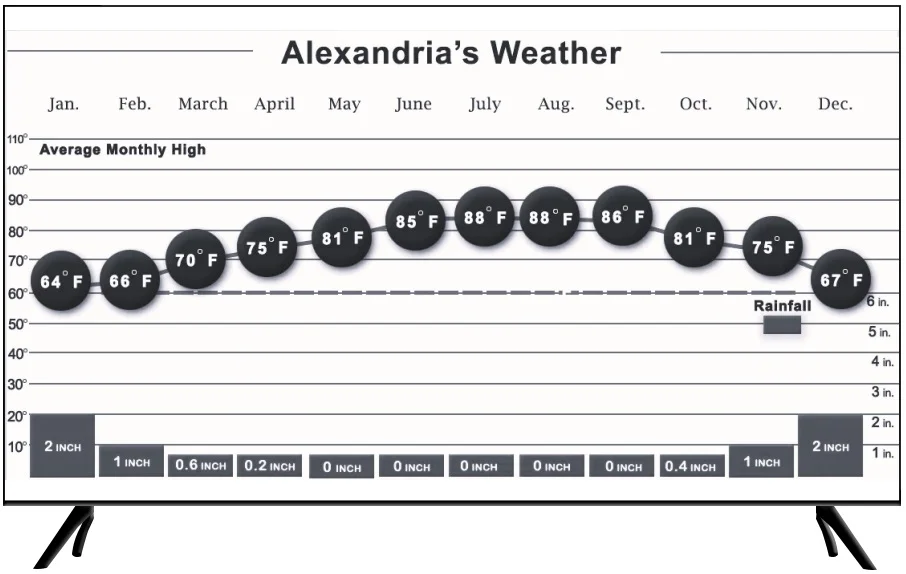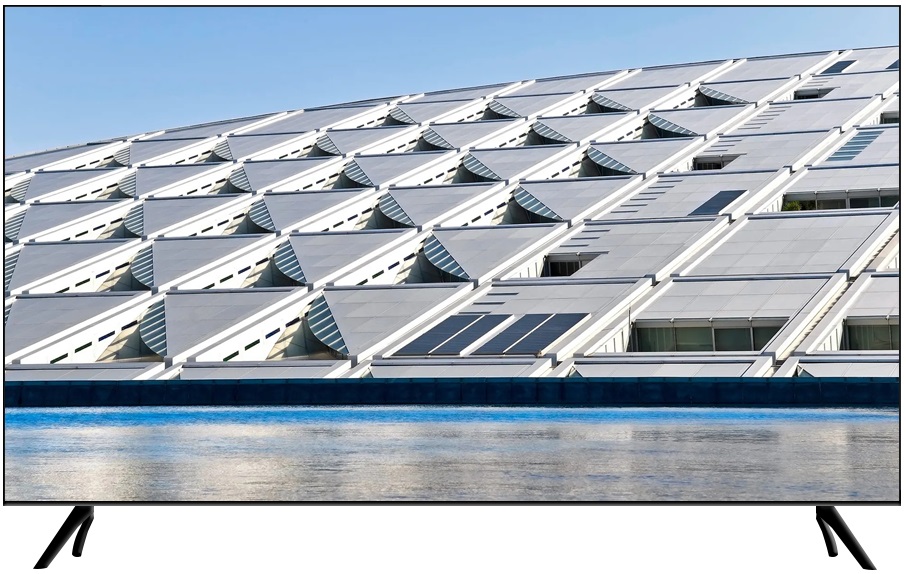


Day 5. Alexandria
Overnight - Four Seasons Alexandria
Please note that all the sights detailed below are within a fairly small historical area and walking between attractions, for those who like to walk, is recommended. You also do not need to visit all the attractions, and your Egyptologist Guide will help you design your day as per your preferences. Among other things, you can ask to visit ancient souks and popular restaurants – Alexandria’s cuisine is famous for its diversity as it is influenced by multiple Mediterranean regions.
Start your exploration of Alexandria in the mid-morning (after the heavy rush-hour traffic) with a drive along the Corniche as you head to the Citadel of Sultan Qaitbay. This fort was built in 1474 AD and was one of the Mediterranean’s best fortifications in its time. Constructed at the same spot where the legendary Lighthouse of Alexandria once stood, many of its massive stones were originally part of the lighthouse, which had completely collapsed by the 14th century. The current structure has seen major renovations, especially after the British bombarded it in the 19th century, and after a brief tour, you will enjoy a 15-minute walk (driving is an option for those who do not want to walk) on the corniche with the sea on one side and some of Alexandria’s older sights on the other.
The walk will end at the Abu al-Abbas Al-Mursi Mosque. Dedicated to a 13th Century Sufi Saint, this beautiful mosque was originally constructed in 1307 AD, but was subsequently destroyed and rebuilt. Your stop here will be a brief photo opportunity. After the mosque a short drive will bring you to what many visitors consider Alexandria’s most impressive remaining ancient site, the Catacombs of Kom el Shokafa, part of the aforementioned Wonder of the Middle Ages, the Necropolis.
The tombs in the three-tiered solid stone (the bottom tier is now submerged) catacomb are said to have been used for about two hundred years starting from the 2nd Century. The catacombs are extremely impressive in scale and the details, including the carvings and pillars, and the timeless feeling that the site evokes. Kom el Shokafa means Mound of Chards. The name originates from what was discovered in these catacombs in 1900 AD by a working donkey who fell down a hidden shaft. When the experts subsequently entered, they found that the common areas of the catacombs had a number of piles of smashed ancient pottery. Archaeologists believe that when visitors came to their relatives’ graves, they would stay for a meal that they had brought along. Not wanting to take the pottery used for this meal to their homes, they shattered them and left them in the piles.
A 3-minute drive will bring you to the Serapeum and Pompey’s Pillar. This site is almost completely in ruins and was extensively plundered long ago. The Serapeum at Alexandria was a magnificent Greek Temple constructed in the 3rd Century BC. At one time this was the largest and most impressive temple in Alexandria, but now the remaining attraction here is Pompey’s Pillar. Erected in the 3rd Century AD to honor the Roman emperor, this gray granite monolith is 88 feet high and still one of the largest of its kind on our planet. Although the Serapeum has some areas to explore, including its own catacombs, it is Pompey’s Pillar that is the main attraction here, and it is well worth the stop.
You can choose to break for lunch at any time you want during this day’s sightseeing – your guide will give you your nearby dining options. Another short drive from the Serapeum (you can choose to get off well before you arrive and walk on the corniche with your guide) will bring you to the location next to the Great Library of Alexandria. The original library that was built here between the 4th and 3rd Century BC was arguably the world’s greatest library during its first couple of centuries of existence, but after that it gradually lost prominence and what remained was eventually destroyed by the ruling Christians. The greatest geniuses in the world, including Aristotle, are said to have had volumes of their writings on papyrus stored at the library.
What currently stands very near the ancient library is the Bibliotheca Alexandrina. This spectacular structure was inaugurated in 2002 after 6 years of construction and an expense of $220 million at that time. Please note that this massive complex is closed on Fridays and public holidays. Its incredible architecture and design, both inside and out, are alone well worth a visit – the sea view is quite amazing from the gorgeous main reading room with its 105-foot-high glass roof. This is actually a massive Cultural Centre, there are multiple museums, art galleries, permanent and rotating exhibition halls, a planetarium, manuscript restoration project, specialized libraries for maps, the visually impaired, children, and a lot more. Your guide will offer you a brief tour of some of the highlights and any section you want to visit.
From here you will drive nearby to Stanley Bridge for a short walk across the small bay while you enjoy the wonderful views. This pretty bridge is 100 feet wide and a quarter mile long and is considered a part of the corniche by the locals. From the bridge you will be driven back to your hotel.
Please note that all the sights detailed below are within a fairly small historical area and walking between attractions, for those who like to walk, is recommended. You also do not need to visit all the attractions, and your Egyptologist Guide will help you design your day as per your preferences. Among other things, you can ask to visit ancient souks and popular restaurants – Alexandria’s cuisine is famous for its diversity as it is influenced by multiple Mediterranean regions.
Start your exploration of Alexandria in the mid-morning (after the heavy rush-hour traffic) with a drive along the Corniche as you head to the Citadel of Sultan Qaitbay. This fort was built in 1474 AD and was one of the Mediterranean’s best fortifications in its time. Constructed at the same spot where the legendary Lighthouse of Alexandria once stood, many of its massive stones were originally part of the lighthouse, which had completely collapsed by the 14th century. The current structure has seen major renovations, especially after the British bombarded it in the 19th century, and after a brief tour, you will enjoy a 15-minute walk (driving is an option for those who do not want to walk) on the corniche with the sea on one side and some of Alexandria’s older sights on the other.
The walk will end at the Abu al-Abbas Al-Mursi Mosque. Dedicated to a 13th Century Sufi Saint, this beautiful mosque was originally constructed in 1307 AD, but was subsequently destroyed and rebuilt. Your stop here will be a brief photo opportunity. After the mosque a short drive will bring you to what many visitors consider Alexandria’s most impressive remaining ancient site, the Catacombs of Kom el Shokafa, part of the aforementioned Wonder of the Middle Ages, the Necropolis.
The tombs in the three-tiered solid stone (the bottom tier is now submerged) catacomb are said to have been used for about two hundred years starting from the 2nd Century. The catacombs are extremely impressive in scale and the details, including the carvings and pillars, and the timeless feeling that the site evokes. Kom el Shokafa means Mound of Chards. The name originates from what was discovered in these catacombs in 1900 AD by a working donkey who fell down a hidden shaft. When the experts subsequently entered, they found that the common areas of the catacombs had a number of piles of smashed ancient pottery. Archaeologists believe that when visitors came to their relatives’ graves, they would stay for a meal that they had brought along. Not wanting to take the pottery used for this meal to their homes, they shattered them and left them in the piles.
A 3-minute drive will bring you to the Serapeum and Pompey’s Pillar. This site is almost completely in ruins and was extensively plundered long ago. The Serapeum at Alexandria was a magnificent Greek Temple constructed in the 3rd Century BC. At one time this was the largest and most impressive temple in Alexandria, but now the remaining attraction here is Pompey’s Pillar. Erected in the 3rd Century AD to honor the Roman emperor, this gray granite monolith is 88 feet high and still one of the largest of its kind on our planet. Although the Serapeum has some areas to explore, including its own catacombs, it is Pompey’s Pillar that is the main attraction here, and it is well worth the stop.
You can choose to break for lunch at any time you want during this day’s sightseeing – your guide will give you your nearby dining options. Another short drive from the Serapeum (you can choose to get off well before you arrive and walk on the corniche with your guide) will bring you to the location next to the Great Library of Alexandria. The original library that was built here between the 4th and 3rd Century BC was arguably the world’s greatest library during its first couple of centuries of existence, but after that it gradually lost prominence and what remained was eventually destroyed by the ruling Christians. The greatest geniuses in the world, including Aristotle, are said to have had volumes of their writings on papyrus stored at the library.
What currently stands very near the ancient library is the Bibliotheca Alexandrina. This spectacular structure was inaugurated in 2002 after 6 years of construction and an expense of $220 million at that time. Please note that this massive complex is closed on Fridays and public holidays. Its incredible architecture and design, both inside and out, are alone well worth a visit – the sea view is quite amazing from the gorgeous main reading room with its 105-foot-high glass roof. This is actually a massive Cultural Centre, there are multiple museums, art galleries, permanent and rotating exhibition halls, a planetarium, manuscript restoration project, specialized libraries for maps, the visually impaired, children, and a lot more. Your guide will offer you a brief tour of some of the highlights and any section you want to visit.
From here you will drive nearby to Stanley Bridge for a short walk across the small bay while you enjoy the wonderful views. This pretty bridge is 100 feet wide and a quarter mile long and is considered a part of the corniche by the locals. From the bridge you will be driven back to your hotel.

